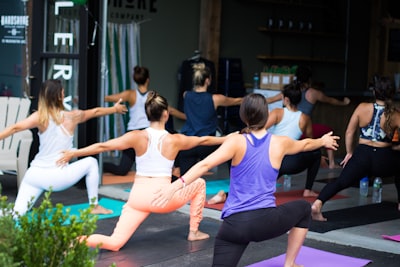Yoga for Pain Relief: Ultimate Guide to Finding Relief

Key Highlights
- Recent research reveals promising evidence supporting yoga’s effectiveness in pain management.
- Yoga offers a holistic approach, addressing the physical, mental, and emotional aspects of pain.
- Gentle to intermediate poses can be tailored to target specific pain conditions and individual needs.
- Integrating yoga into daily routines can contribute to long-term pain relief and improved well-being.
- Consulting healthcare professionals and certified yoga instructors ensures safe and effective practice.
Introduction
Effective pain management is very important for improving our quality of life. While usual methods can help, looking into other options like yoga can lead to better relief. Yoga focuses on physical movements, breath control, and relaxation techniques. It can gently and powerfully help with pain right from the source.
Understanding Yoga and Pain Relief

Yoga comes from old Indian traditions. It is a practice that brings together the body and mind. Many see yoga just as an exercise, but it is much more than that. Yoga for pain relief includes physical poses, breathing exercises, and meditation to help with pain in different ways.
Through yoga, you can get more flexible, make your muscles stronger, and feel relaxed. This well-rounded way of dealing with pain not only eases physical issues but also helps people build a better connection between their mind and body.
The Science Behind Yoga as a Pain Management Tool

Yoga has many benefits for pain management. Research shows that when people practice yoga regularly, their bodies change in ways that affect how they feel and deal with pain.
One important point is how yoga affects the nervous system. By focusing on deep breathing and relaxation techniques, yoga helps reduce the activity of the sympathetic nervous system. This part of the nervous system is responsible for the “fight-or-flight” response. Lowering this activity also lowers stress hormones like cortisol, which can make pain feel worse.
Additionally, yoga helps improve flexibility and range of motion, which helps fix body imbalances that cause pain. Because of these effects, yoga is a strong option for managing both acute and chronic pain conditions.
Types of Pain Addressed by Yoga Practices

Yoga can help with many types of pain. It works for long-term pain that stays for a while and sudden pain from injuries. Many people find relief through flexible yoga practices.
Back pain affects many individuals around the world. Targeted yoga postures can bring comfort. By building up core muscles, helping with back motion, and easing tension, yoga is a natural way to deal with both chronic and sudden back pain.
Joint pain from issues like arthritis can also be managed well with gentle yoga moves. This practice focuses on smooth movements and good body alignment. This can help joints stay lubricated, decrease stiffness, and improve range of motion. This helps to reduce pain and improve joint health.
Essential Yoga Poses for Pain Management

Starting a yoga journey for pain relief usually begins with easy poses that beginners can do. These poses help improve flexibility, build strength, and increase awareness of the body. This sets a solid base for a long-term yoga practice.
As people become more skilled, adding intermediate poses can boost the healing effects of yoga. These poses push the body more while improving alignment and making muscles stronger. This can lead to better pain relief and improved overall health.
Gentle Poses for Beginners

For beginners, trying gentle Hatha yoga poses is a good way to manage pain. These poses focus on simple stretches and exercises. They help improve flexibility and increase your range of motion over time.
Here are a few examples:
- Child’s Pose: This pose gently stretches the spine, hips, and lower back. It can relieve tension and help you feel calm.
- Cat-Cow Pose: In this pose, you alternate between arching and rounding your spine. This flow improves spinal flexibility and eases tightness in your back and neck.
- Triangle Pose: This standing pose stretches your hamstrings, hips, and spine. It also helps strengthen your legs and core, boosting balance and stability.
Always remember to move slowly and with care. Listen to your body, and avoid any movements that hurt you.
Intermediate Poses for Enhanced Relief
As you continue to practice, adding some intermediate poses from Iyengar yoga can help reduce pain. These poses focus on fixing muscle imbalances. They often use props to help with aligning your body and extending the stretches.
One good pose to try is Bridge Pose. In this pose, you lie on your back with your knees bent and lift your hips off the ground. This move strengthens your back, glutes, and hamstrings. It also offers a nice stretch for your chest and shoulders.
Another helpful pose is Downward-Facing Dog. This pose is important in many yoga styles. Here, you create an upside-down “V” shape with your body, stretching your back from your heels to the crown of your head. It can help relieve back pain, improve circulation, and calm your mind.
Yoga for Specific Pain Conditions
Customizing yoga practices to help with specific pain can often bring better relief. When you know what causes your pain, you can choose poses that give the best support and promote healing.
For example, people with lower back pain might find relief with poses that make the core stronger, help with spine movement, and ease tension. Similarly, those who have neck pain can benefit from poses that gently stretch and strengthen the muscles in their neck, shoulders, and upper back.
Yoga Techniques for Lower Back Pain

Low back pain is a common reason why many people visit doctors. Yoga can help with low back pain. Yoga therapy focuses on poses that improve spinal flexibility. It can also strengthen core muscles and relieve muscle tension.
Effective poses include Cat-Cow, Sphinx, and Cobra. These poses help move the spine and reduce lower back pain. Practicing them regularly can help manage chronic low back pain over time.
Breathing exercises, such as diaphragmatic breathing, can also help. They relax the muscles around the lower back. This can cut down pain and make you feel more comfortable overall.
Managing Neck and Shoulder Tension with Yoga
For those who have neck pain and shoulder tightness, yoga can help. This pain often comes from sitting at a desk too long or having bad posture. Yoga offers gentle ways to help feel better.
Doing poses that stretch and strengthen the neck, shoulders, and upper back can bring relief. Simple neck stretches like Ear-to-Shoulder and Chin-to-Chest can help reduce stiffness. Poses like Thread the Needle and Puppy Pose are good for releasing tension in the shoulders and upper back.
Also, using relaxation techniques, like guided meditation or deep breathing exercises, can help ease muscle tension. This promotes calmness and can lessen pain and discomfort.
Integrating Yoga into Your Pain Management Routine
Integrating yoga into your pain management routine requires more than just doing poses. You need to create a home practice that matches your specific needs and limits. Setting up a space just for yoga and having achievable goals can help you stay consistent.
When you practice yoga is also very important for pain relief. The best times to do yoga can be different for everyone. However, many find that practicing in the morning or before going to bed can help manage pain and improve well-being effectively.
Creating a Sustainable Yoga Practice at Home
Establishing a home practice for yoga is important for the long-term benefits of pain management. First, choose a quiet and comfortable spot where you can practice without distractions.
Start with shorter sessions. Over time, you can increase how long and how harder you practice as your body gets used to it. Focus on yoga postures that tailor to your specific needs while being careful about your limits.
Being consistent is important. Even spending just a few minutes each day can help. In the end, you will see that small, regular efforts can greatly help in managing pain and improving your overall comfort and well-being.
When to Practice: Best Times for Pain Relief
Adding yoga to your routine can be great, but the best time for pain relief varies from person to person. Some people like to do yoga in the morning. It helps wake up the body, increase flexibility, and reduce pain for the day ahead.
Others prefer evening yoga. It helps them unwind, let go of stress from the day, and sleep better. This can help a lot with pain that gets worse at night.
The best way to find the right time for your yoga practice is to try different times and see how your body reacts.
Real-life Success Stories
Yoga has a strong ability to change lives, showing its benefits through real stories of people who found relief from pain. These stories not only inspire us but also prove that yoga can really help with pain management.
People have found help for chronic conditions that affected their quality of life for a long time. Others have turned to yoga for relief from sudden pain. These experiences highlight how yoga can greatly improve health and well-being.
From Chronic Pain to Daily Comfort
“For years, I struggled with chronic back pain. It took away my quality of life and made everything difficult,” says Sarah, a yoga lover who found yoga to help with her pain.
At first, she was unsure about it. So, she slowly added gentle yoga poses and breathing exercises to her day. “I was surprised when, within weeks, I felt a change,” she shares. “The pain felt less, and I noticed my body getting stronger and more flexible.”
Now, Sarah believes yoga is very important in her journey to regain her life from chronic pain. She is one of many people who have found the benefits of yoga in improving their well-being.
How Yoga Transformed My Pain Management Journey
Mark loves to run, but he had to stop because of knee pain. He said, “Running was my escape, my way to relax,” but the pain made it too hard for him. Mark got frustrated with regular methods that only gave him short relief. So, he decided to try yoga.
He found out that “Yoga wasn’t just stretching; it was about knowing my body and fixing what caused the pain,” he explains. As Mark practiced more yoga, he did poses that made his core stronger and helped his flexibility. He noticed a change.
Mark said, “The pain didn’t go away right away, but I felt strong and in control of my body for the first time.” This feeling of strength, along with the steady yet important decrease in his pain, shows how yoga can change life and help with pain management.
Expert Insights on Yoga for Pain Management
Getting advice from certified yoga instructors and healthcare experts is important for starting a safe and effective yoga journey. These professionals give helpful guidance suited to your needs.
They can suggest specific poses, changes, and safety tips. This ensures your practice fits your health conditions and limits. Their knowledge supports your path to overall well-being.
Professional Recommendations for Safe Practice
When using yoga for pain management, it is very important to practice safely. It helps to talk to healthcare professionals, especially if you have health conditions. They can help make sure your yoga practice fits your needs and limits.
Here are some professional recommendations:
- Get approval from your doctor. This is very important for those with long-term health conditions or who have had recent injuries.
- Start slow and increase intensity little by little. Do not force your body beyond its limits, especially at first.
- Talk openly with your yoga teacher. Let them know if you feel any pain or discomfort during your practice.
Following these tips can help you enjoy the benefits of yoga while reducing the chance of injuries.
Avoiding Common Mistakes in Yoga Pain Management
While yoga offers a path toward pain relief, certain common mistakes can hinder progress and potentially lead to injuries. Being aware of these pitfalls and seeking proper guidance helps ensure a safe and effective practice.
One frequent error is pushing into pain, often stemming from the misconception that discomfort equals progress. Instead, yoga training emphasizes honoring your body’s limits and opting for modifications when needed.
Another mistake is neglecting the breath, a fundamental aspect of yoga practice. Deep, conscious breathing enhances the physical benefits of yoga and promotes relaxation, essential for pain management.
Here’s a table highlighting common mistakes and how to avoid them:
| Mistake | How to Avoid |
| Pushing into pain | Honor your body’s limits and modify poses as needed. |
| Neglecting the breath | Focus on deep, conscious breathing throughout your practice |
| Comparing yourself to others | Remember that yoga is an individual journey; progress varies. |
| Skipping warm-ups and cool-downs | Prepare your body for practice and allow for gradual transitions. |
Conclusion
In conclusion, adding yoga to your pain management routine can help you feel better and improve your well-being. The gentle poses can focus on areas that hurt, giving you comfort and relaxation. By practicing yoga regularly and making it part of your daily life, you can change how you deal with pain. It doesn’t matter if you are new or have been doing yoga for some time. Yoga provides a whole approach to pain relief that works well and lasts. Use the healing power of yoga to find comfort and support in your journey of pain management.
Frequently Asked Questions
Can yoga replace traditional pain management methods?
Yoga therapy can help with pain relief in a complete way. However, it is important to remember that it is not a replacement for regular pain management methods. You should talk to healthcare professionals to diagnose and treat any health conditions. This is especially important if you are feeling severe or ongoing pain.
How long does it take to see results from yoga for pain management?
The time it takes to feel pain relief from yoga practice can be different for everyone. It depends on personal factors and the type of pain. Some people may notice quick improvements in pain scores and how well they can move. Others might enjoy long-term benefits if they practice regularly.
Are there any risks involved with using yoga for pain relief?
Practicing yoga, like any exercise therapy, has some risks. These risks are higher if you don’t do it right or if you have health conditions. To stay safe, it’s important to learn from certified instructors. You should also talk to healthcare professionals about any safety concerns you may have.
What type of yoga is most effective for dealing with chronic pain?
Many types of yoga can help manage chronic pain. Styles like Hatha, Iyengar, and Restorative yoga focus on gentle movements, breath control, and proper alignment. It is important to pick a yoga style and postures that fit your body’s needs and limits.
How can beginners safely start yoga for pain management?
Beginners who want to use yoga for pain management should get help from certified instructors. These instructors have experience working with people in pain. It’s best to start with gentle poses. Remember to listen to your body and not push too hard. By slowly increasing the difficulty of your practice, you can safely enjoy the benefits of yoga for pain relief.
https://www.benefits.va.gov/BENEFITS/Applying.asp
https://www.ncbi.nlm.nih.gov/pubmed/28631003
https://www.research.va.gov/currents
https://www.cem.va.gov/burial_benefits/burial_flags.asp
https://www.mentalhealth.va.gov
https://pubmed.ncbi.nlm.nih.gov/30714983
https://www.blogs.va.gov/nvspse/national-veterans-golden-age-games